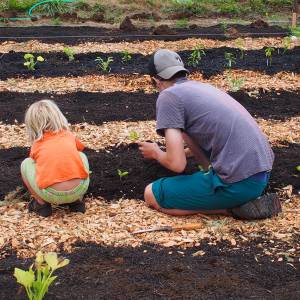Gardening in winter and looking forward toward spring!
Update from our farm (by Will Summers and Kitty Ufford-Chase)

Greetings from the winter wonderland that is the Stony Point Center!
What a winter it’s been. In the past month, we’ve had snow, snow, and more snow. And it has just kept piling up.
During one recent 24-hour stretch, we probably got about 18 inches! My major concern in a blizzard like that is the greenhouse. It’s not what’s inside the greenhouse that I’m worried about in a snowstorm, but the greenhouse itself. More than a foot of heavy, wet snow has the potential to damage the entire structure.
After this particular snowstorm, Matt and I spent an entire morning clearing snow off the greenhouse roof and then removing all the snow that had piled up on the sides that continued to put pressure on the plastic and the frame. We had to dig in the snow by hand because snow shovels can very easily puncture the greenhouse plastic. It was quite a day-I was soaking wet after spending the entire morning essentially waist-deep in the snow.

Despite the polar vortex, our greenhouse crops continue to grow. We’ve taken extra precautions by double-covering them when weather forecasts indicate temperatures will be in the single-digits (which has been quite frequent this winter). In just the past week, our greenhouse spinach has really started to grow quickly as the days get incrementally longer. We’re still harvesting kale, collards, chard, and arugula from the greenhouse as well.
Recently we’ve put a lot of energy into preparing our greenhouse for spring seeding. In fact, by the end of February, we will have seeded lettuce, spinach, and onions that will be transplanted in the fields in March or April (assuming, of course, that all that snow eventually melts!).
Needless to say, here at Stony Point Center, all of us on the farm crew are eagerly awaiting the arrival of spring.
Peace and winter blessings,
Will (the Stony Point Center Farmer) and Kitty
Read more »
 This reflection comes from Bruce Kelsh, Chair of Earth and Social Justice Committee for First Presbyterian Church, in Cottage Grove, OR. Fifty percent of the people in our rural community are classified as being in poverty or ALICE (Asset Limited Income Constrained), that is, the working poor. There is a shortage of fresh produce for… Read more »
This reflection comes from Bruce Kelsh, Chair of Earth and Social Justice Committee for First Presbyterian Church, in Cottage Grove, OR. Fifty percent of the people in our rural community are classified as being in poverty or ALICE (Asset Limited Income Constrained), that is, the working poor. There is a shortage of fresh produce for… Read more »
 This reflection comes from Bruce Kelsh, Chair of Earth and Social Justice Committee for First Presbyterian Church, in Cottage Grove, OR. Fifty percent of the people in our rural community are classified as being in poverty or ALICE (Asset Limited Income Constrained), that is, the working poor. There is a shortage of fresh produce for… Read more »
This reflection comes from Bruce Kelsh, Chair of Earth and Social Justice Committee for First Presbyterian Church, in Cottage Grove, OR. Fifty percent of the people in our rural community are classified as being in poverty or ALICE (Asset Limited Income Constrained), that is, the working poor. There is a shortage of fresh produce for… Read more »



